Aspects of Lexical Meaning Lecture ASPECTS OF
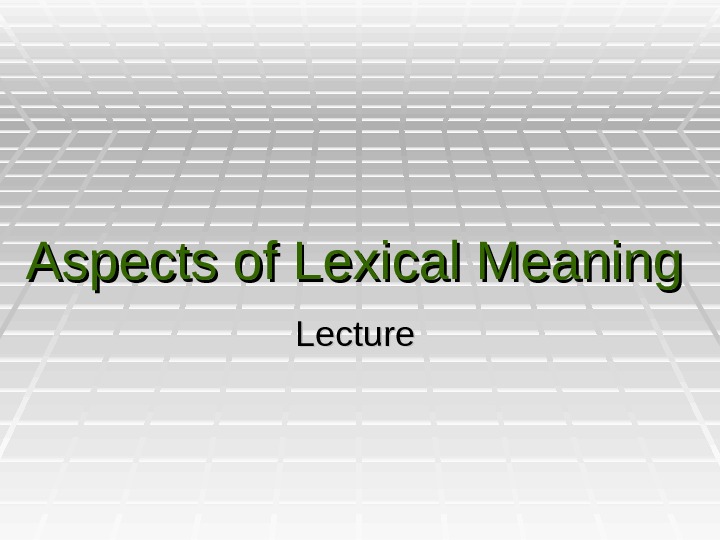
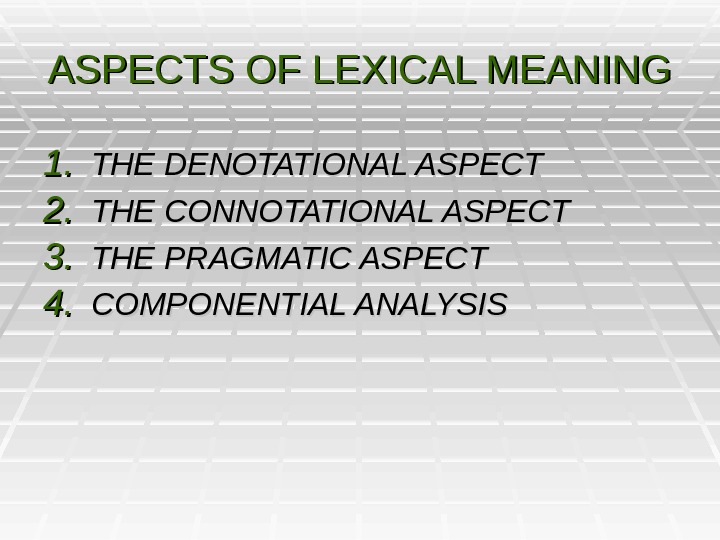
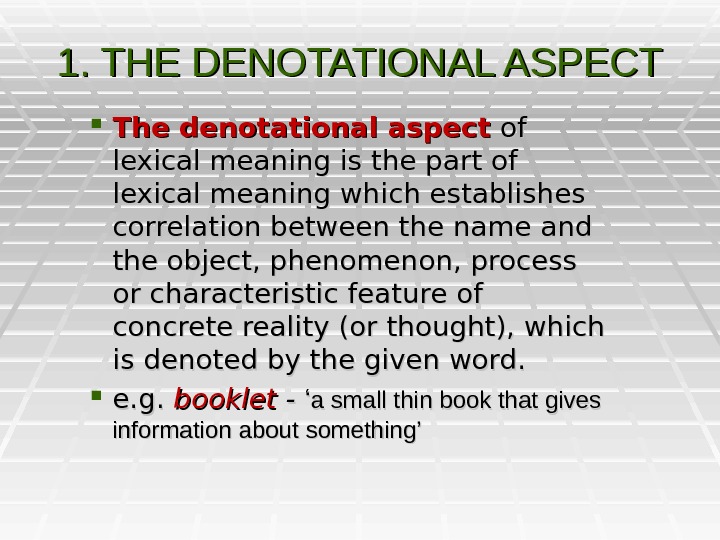
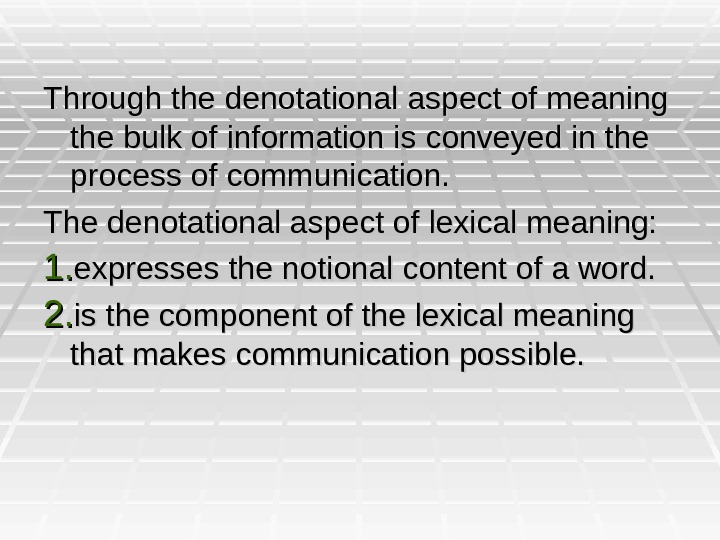

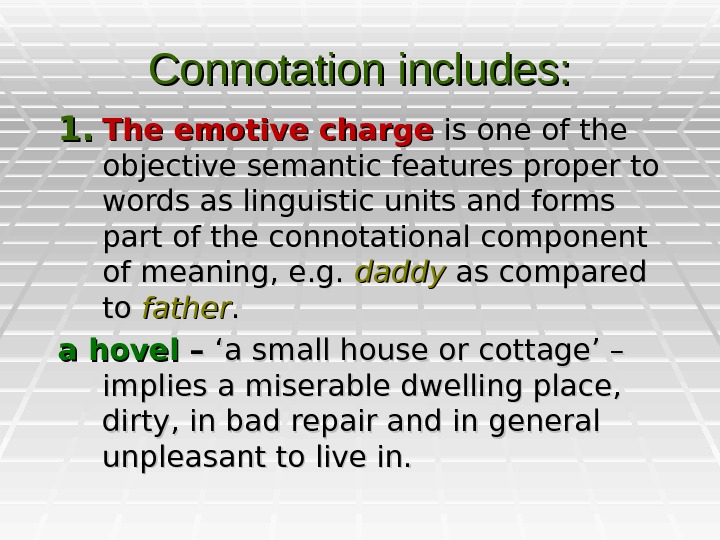
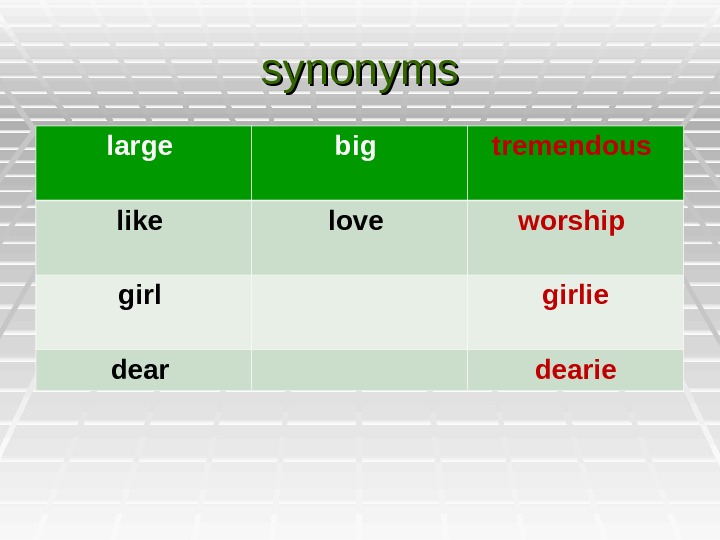
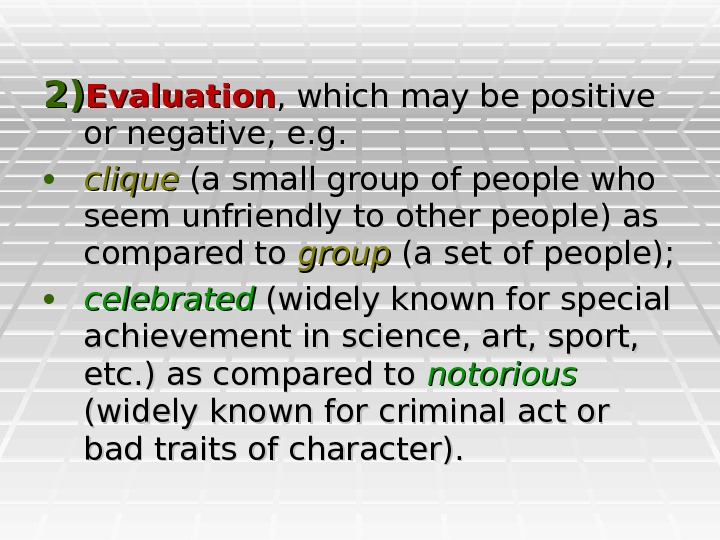
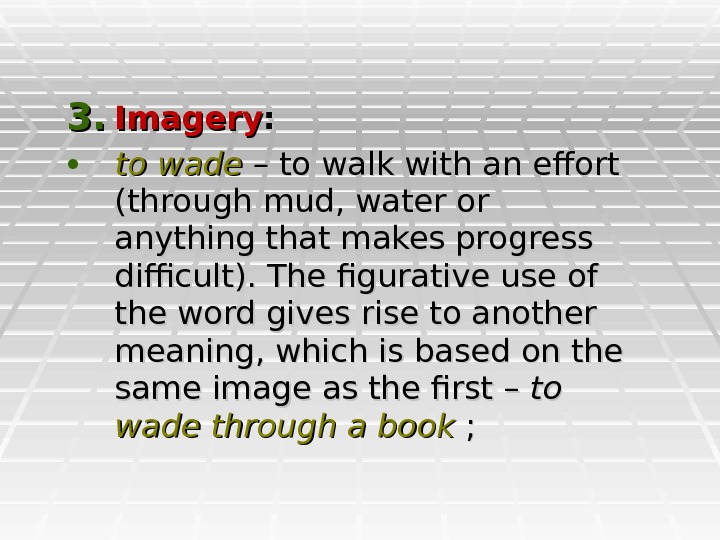
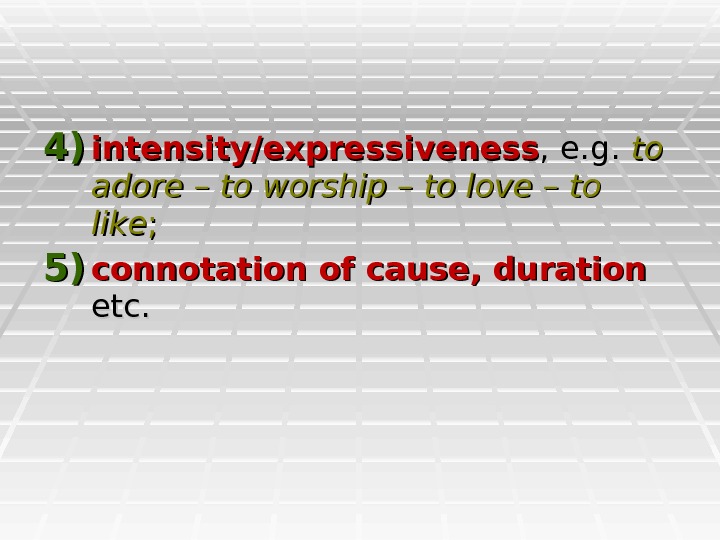
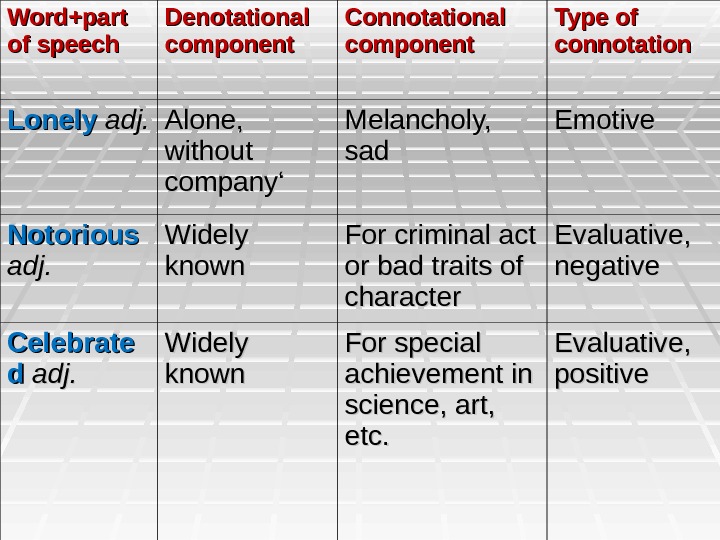


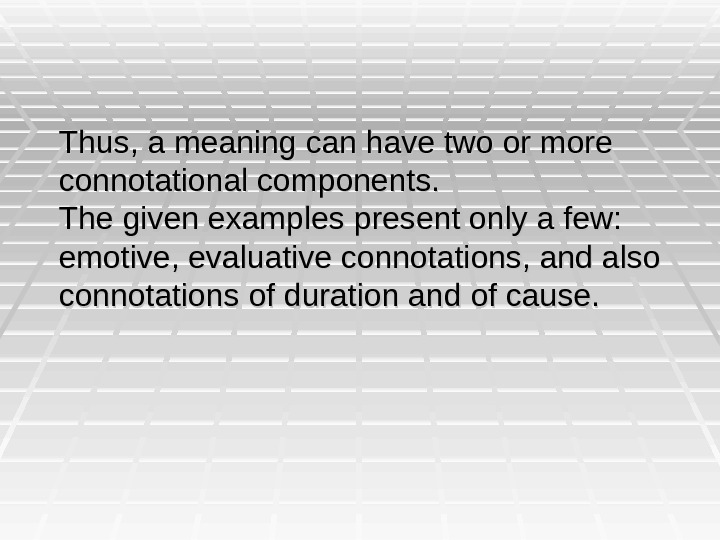


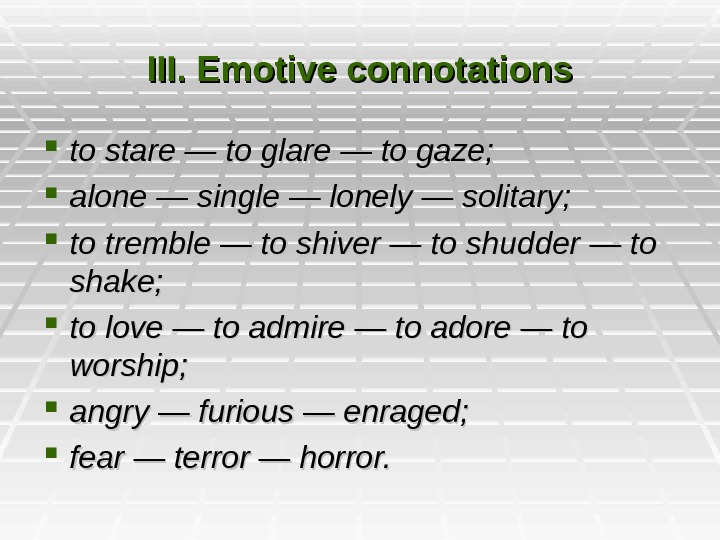

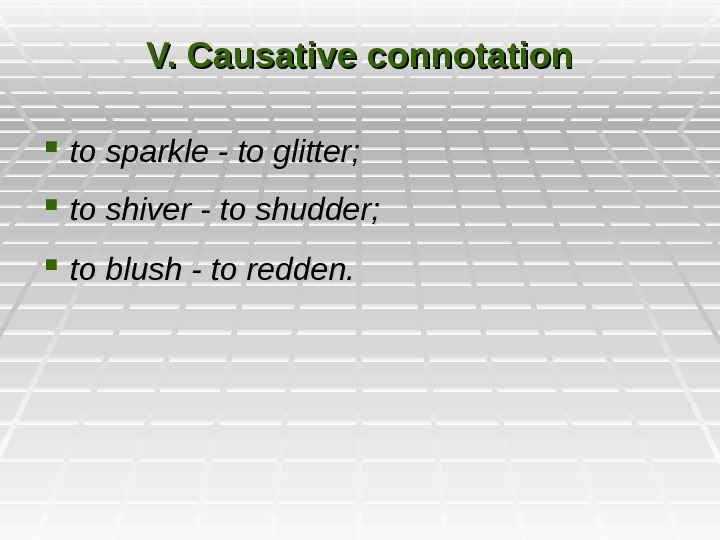
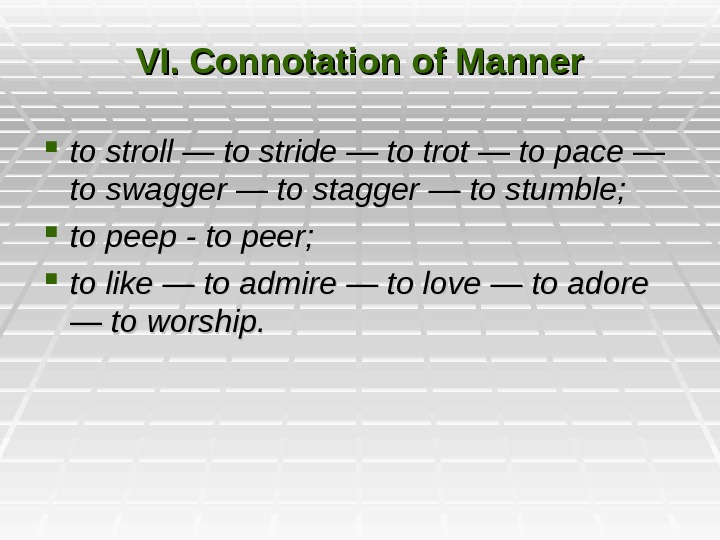
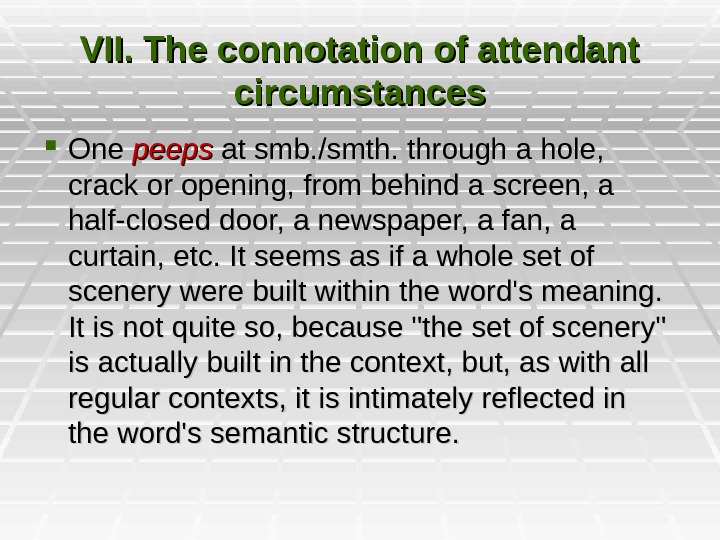
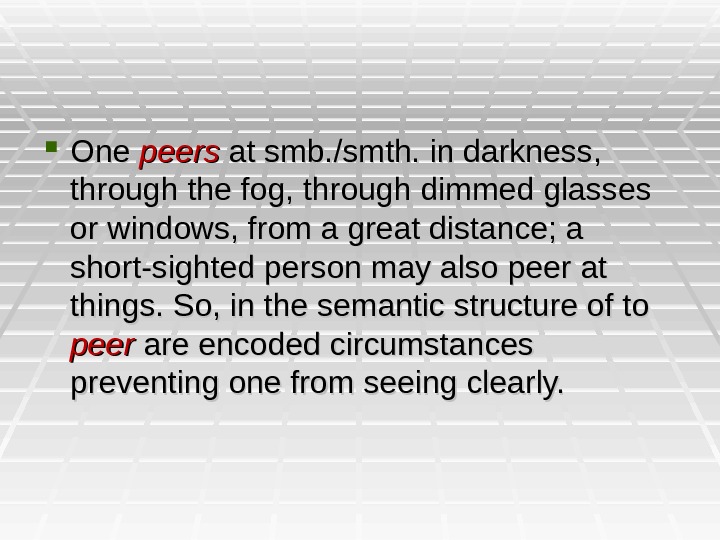

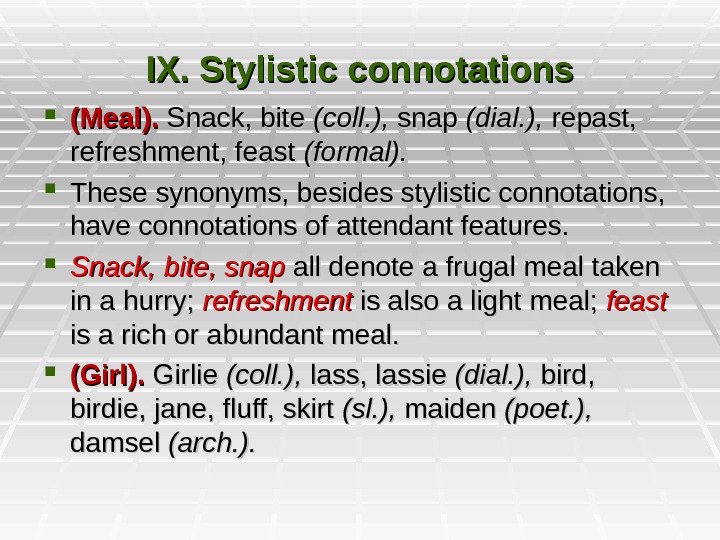




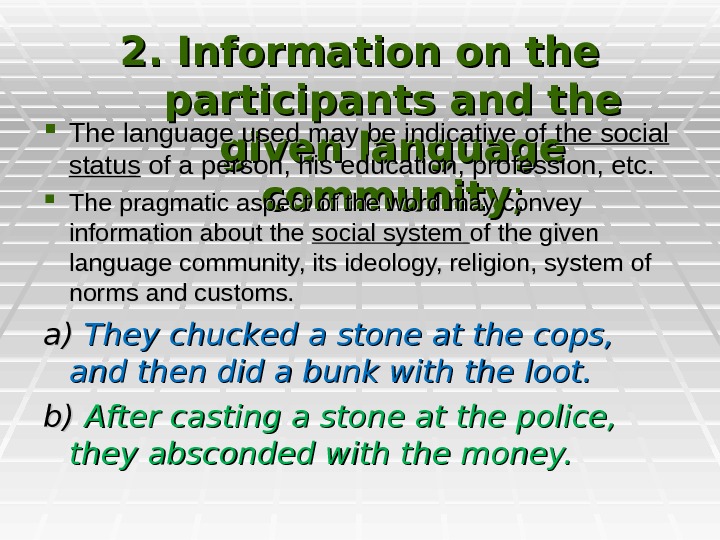

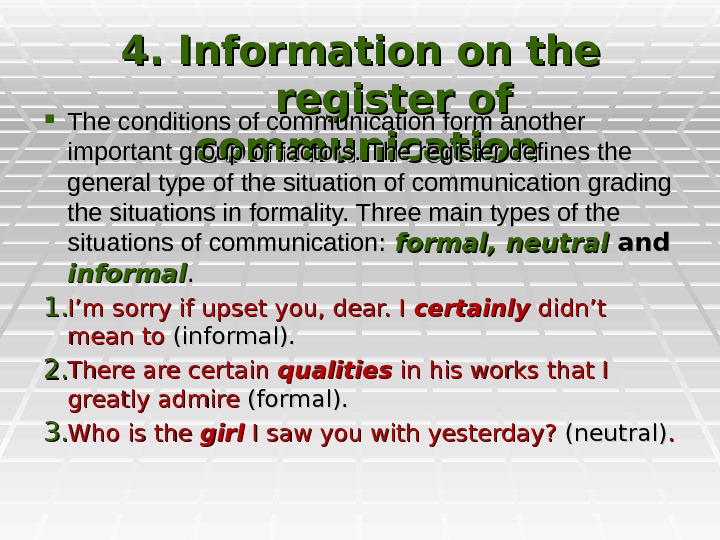
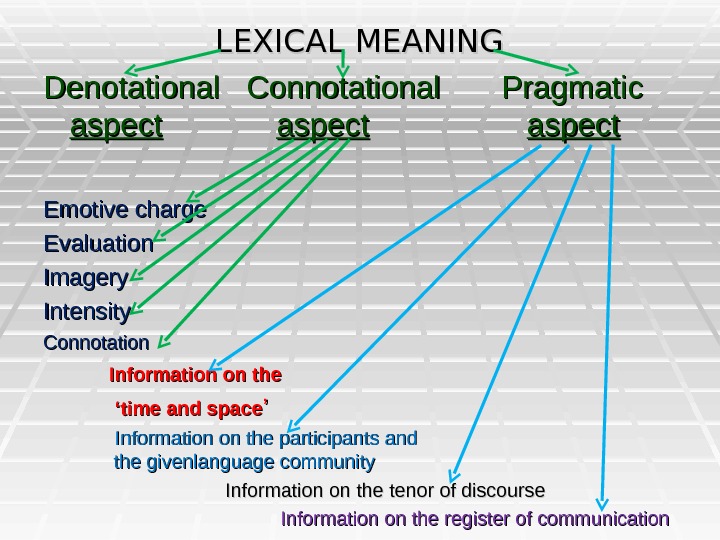
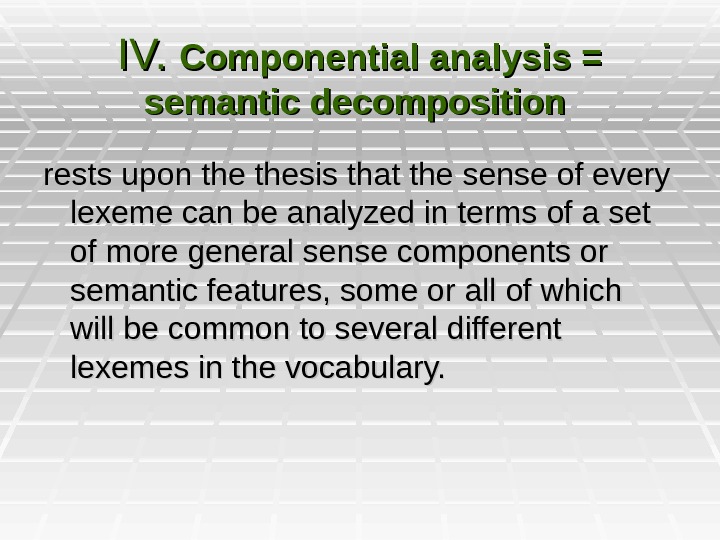
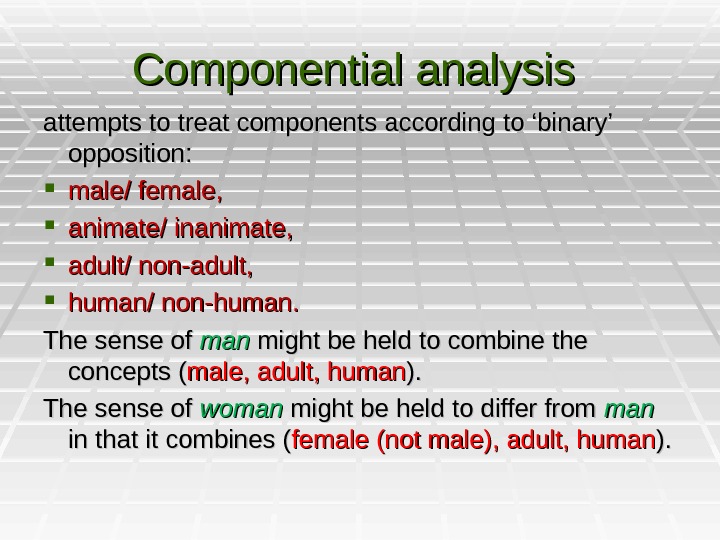
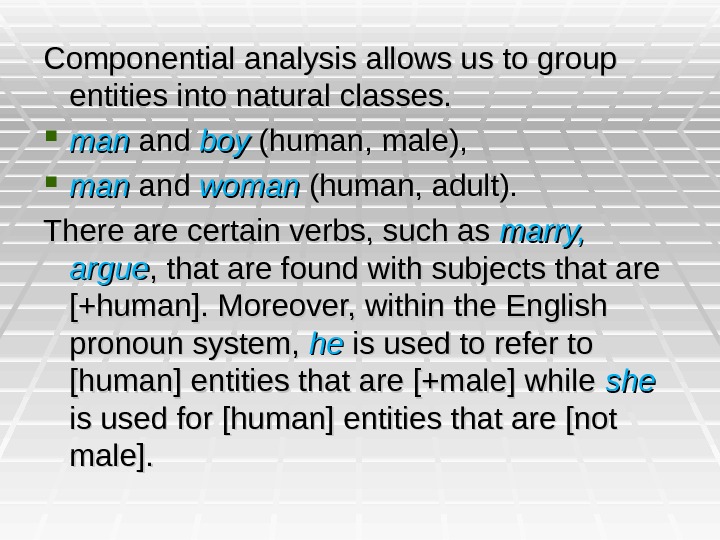

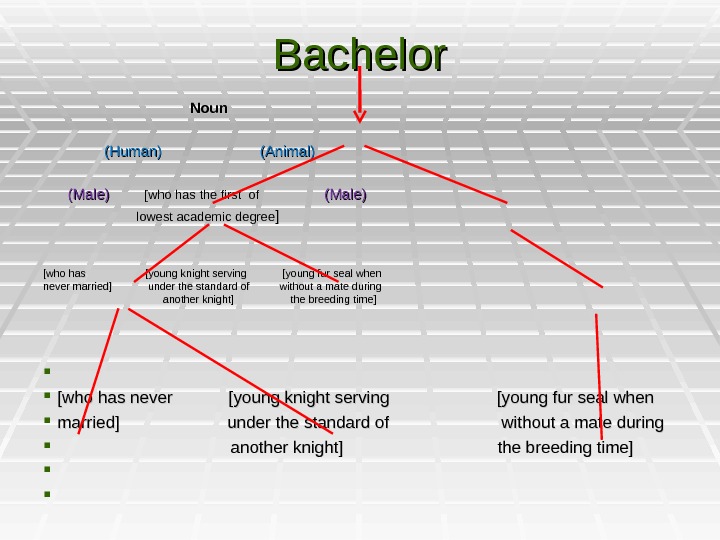
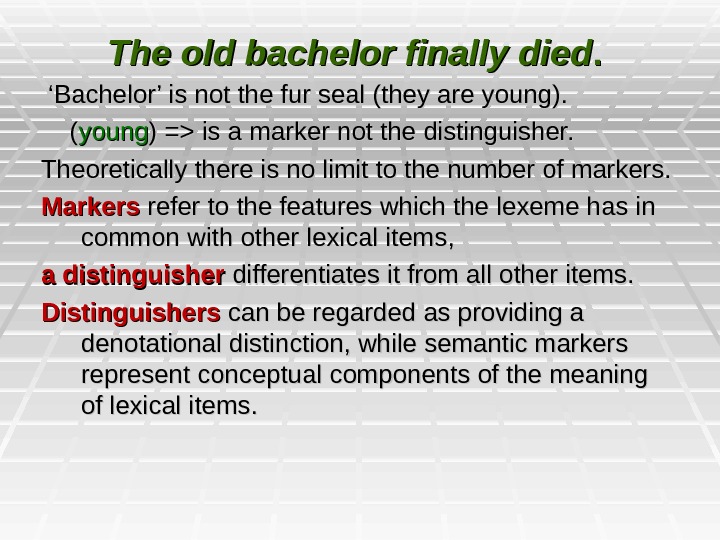
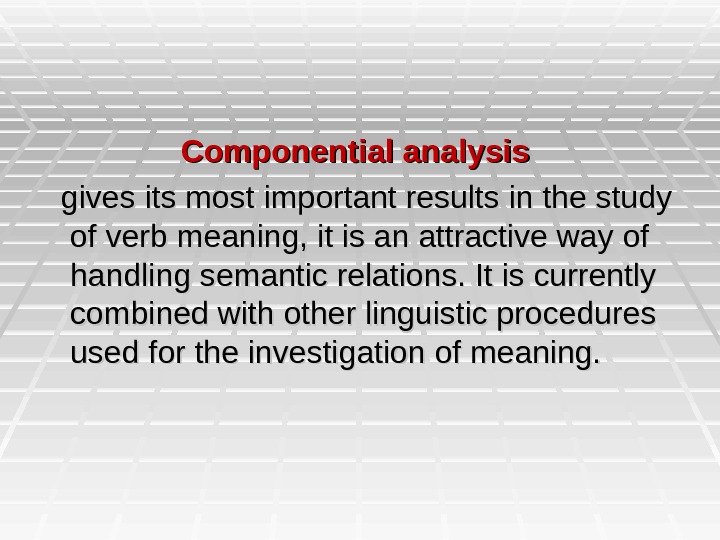
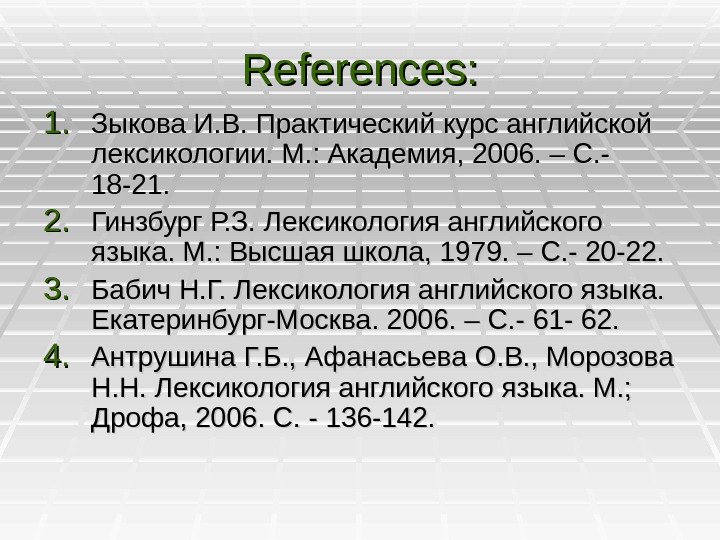
pr2_aspect_of_lexical_meaning1.ppt
- Размер: 782 Кб
- Количество слайдов: 40
Описание презентации Aspects of Lexical Meaning Lecture ASPECTS OF по слайдам
 Aspects of Lexical Meaning Lecture
Aspects of Lexical Meaning Lecture
 ASPECTS OF LEXICAL MEANING 1. 1. THE DENOTATIONAL ASPECT 2. 2. THE CONNOTATIONAL ASPECT 3. 3. THE PRAGMATIC ASPECT 4. 4. COMPONENTIAL ANALYSIS
ASPECTS OF LEXICAL MEANING 1. 1. THE DENOTATIONAL ASPECT 2. 2. THE CONNOTATIONAL ASPECT 3. 3. THE PRAGMATIC ASPECT 4. 4. COMPONENTIAL ANALYSIS
 1. THE DENOTATIONAL ASPECT The denotational aspect of of lexical meaning is the part of lexical meaning which establishes correlation between the name and the object, phenomenon, process or characteristic feature of concrete reality (or thought), which is denoted by the given word. e. g. booklet — — ‘‘ a small thin book that gives information about something’
1. THE DENOTATIONAL ASPECT The denotational aspect of of lexical meaning is the part of lexical meaning which establishes correlation between the name and the object, phenomenon, process or characteristic feature of concrete reality (or thought), which is denoted by the given word. e. g. booklet — — ‘‘ a small thin book that gives information about something’
 Through the denotational aspect of meaning the bulk of information is conveyed in the process of communication. The denotational aspect of lexical meaning: 1. 1. expresses the notional content of a word. 2. 2. is the component of the lexical meaning that makes communication possible.
Through the denotational aspect of meaning the bulk of information is conveyed in the process of communication. The denotational aspect of lexical meaning: 1. 1. expresses the notional content of a word. 2. 2. is the component of the lexical meaning that makes communication possible.
 2. THE CONNOTATIONAL ASPECT The connotational aspect of lexical meaning is the part of meaning which reflects the attitude of the speaker towards what he speaks about. Connotation conveys additional information in the process of communication.
2. THE CONNOTATIONAL ASPECT The connotational aspect of lexical meaning is the part of meaning which reflects the attitude of the speaker towards what he speaks about. Connotation conveys additional information in the process of communication.
 Connotation includes: 1. 1. The emotive charge is one of the objective semantic features proper to words as linguistic units and forms part of the connotational component of meaning, e. g. daddy as compared to to father. . a hovel – – ‘a small house or cottage’ – implies a miserable dwelling place, dirty, in bad repair and in general unpleasant to live in.
Connotation includes: 1. 1. The emotive charge is one of the objective semantic features proper to words as linguistic units and forms part of the connotational component of meaning, e. g. daddy as compared to to father. . a hovel – – ‘a small house or cottage’ – implies a miserable dwelling place, dirty, in bad repair and in general unpleasant to live in.
 synonyms large big tremendous like love worship girlie dearie
synonyms large big tremendous like love worship girlie dearie
 2)2) EE valuation , which may be positive or negative, e. g. • clique (a small group of people who seem unfriendly to other people) as compared to group (a set of people); • celebrated (widely known for special achievement in science, art, sport, etc. ) as compared to notorious (widely known for criminal act or bad traits of character).
2)2) EE valuation , which may be positive or negative, e. g. • clique (a small group of people who seem unfriendly to other people) as compared to group (a set of people); • celebrated (widely known for special achievement in science, art, sport, etc. ) as compared to notorious (widely known for criminal act or bad traits of character).
 3. 3. Imagery : : • to wade – to walk with an effort (through mud, water or anything that makes progress difficult). The figurative use of the word gives rise to another meaning, which is based on the same image as the first – to to wade through a book ; ;
3. 3. Imagery : : • to wade – to walk with an effort (through mud, water or anything that makes progress difficult). The figurative use of the word gives rise to another meaning, which is based on the same image as the first – to to wade through a book ; ;
 4)4) intensity/expressiveness , e. g. to to adore – to worship – to love – to like ; ; 5)5) connotation of cause, duration etc.
4)4) intensity/expressiveness , e. g. to to adore – to worship – to love – to like ; ; 5)5) connotation of cause, duration etc.
 Word+part of speech Denotational component Connotational component Type of connotation Lonely adj. Alone, without company‘ Melancholy, sadsad Emotive Notorious adj. Widely known For criminal act or bad traits of character Evaluative, negative Celebrate dd adj. Widely known For special achievement in science, art, etc. Evaluative, positive
Word+part of speech Denotational component Connotational component Type of connotation Lonely adj. Alone, without company‘ Melancholy, sadsad Emotive Notorious adj. Widely known For criminal act or bad traits of character Evaluative, negative Celebrate dd adj. Widely known For special achievement in science, art, etc. Evaluative, positive
 To glare adj. to look 1. steadily, lastingly Connotation of duration 2. in anger, rage, etcetc Emotive connotation Connotation of cause To glance v. v. to look Briefly, passingly Connotation of duration To gaze v. v. to look Steadily, lastingly in tenderness, admiration Emotive connotation. Word+part of speech Denotational component Connotational component Type of connotation
To glare adj. to look 1. steadily, lastingly Connotation of duration 2. in anger, rage, etcetc Emotive connotation Connotation of cause To glance v. v. to look Briefly, passingly Connotation of duration To gaze v. v. to look Steadily, lastingly in tenderness, admiration Emotive connotation. Word+part of speech Denotational component Connotational component Type of connotation
 Word+p art of speech Denotatio nal componen tt Connotational component Type of connotation To To shiver vv. . to tremble 1. lastingly Connotation of duration 2. usu with the cold Connotation of cause To To shudder v. v. to tremble 1. briefly Connotation of duration 2. with horror, disgust, etc. Connotation of cause Emotive connotation
Word+p art of speech Denotatio nal componen tt Connotational component Type of connotation To To shiver vv. . to tremble 1. lastingly Connotation of duration 2. usu with the cold Connotation of cause To To shudder v. v. to tremble 1. briefly Connotation of duration 2. with horror, disgust, etc. Connotation of cause Emotive connotation
 Thus, a meaning can have two or more connotational components. The given examples present only a few: emotive, evaluative connotations, and also connotations of duration and of cause.
Thus, a meaning can have two or more connotational components. The given examples present only a few: emotive, evaluative connotations, and also connotations of duration and of cause.
 3. Examples of different types of Connotation II. . The connotation of degree or intensity to surprise — — to astonish — — to amaze — — to to astound; to satisfy — — to please — — to content — — to to gratify — — to delight — — to exalt; to shout — — to yell — — to bellow — — to roar; to like — — to admire — — to love — — to adore — — to to worship
3. Examples of different types of Connotation II. . The connotation of degree or intensity to surprise — — to astonish — — to amaze — — to to astound; to satisfy — — to please — — to content — — to to gratify — — to delight — — to exalt; to shout — — to yell — — to bellow — — to roar; to like — — to admire — — to love — — to adore — — to to worship
 II. Connotation of duration to stare — — to glare — — to gaze — — to glance — — to peep — — to peer; to flash (brief) — — to blaze (lasting); to shudder (brief) — — to shiver (lasting); to say (brief) — — to speak, to talk (lasting).
II. Connotation of duration to stare — — to glare — — to gaze — — to glance — — to peep — — to peer; to flash (brief) — — to blaze (lasting); to shudder (brief) — — to shiver (lasting); to say (brief) — — to speak, to talk (lasting).
 III. E motive connotations to stare — — to glare — — to gaze; alone — — single — — lonely — — solitary; to tremble — — to shiver — — to shudder — — to to shake; to love — — to admire — — to adore — — to to worship; angry — — furious — — enraged; fear — — terror — — horror.
III. E motive connotations to stare — — to glare — — to gaze; alone — — single — — lonely — — solitary; to tremble — — to shiver — — to shudder — — to to shake; to love — — to admire — — to adore — — to to worship; angry — — furious — — enraged; fear — — terror — — horror.
 IV. The evaluative connotation well-known — — famous — — notorious — — celebrated; to produce — — to create — — to manufacture — — to to fabricate; to sparkle — to glitter; A. A. His (her) eyes sparkled with amusement, merriment, good humour, high spirits, happiness, etc. (positive emotions). B. B. His (her) eyes glittered with anger, rage, hatred, malice, etc. ( negative emotions).
IV. The evaluative connotation well-known — — famous — — notorious — — celebrated; to produce — — to create — — to manufacture — — to to fabricate; to sparkle — to glitter; A. A. His (her) eyes sparkled with amusement, merriment, good humour, high spirits, happiness, etc. (positive emotions). B. B. His (her) eyes glittered with anger, rage, hatred, malice, etc. ( negative emotions).
 V. Causative connotation to sparkle — to glitter; to shiver — to shudder; to blush — to redden.
V. Causative connotation to sparkle — to glitter; to shiver — to shudder; to blush — to redden.
 VI. Connotation of Manner to stroll — — to stride — — to trot — — to pace — — to swagger — — to stagger — — to stumble; to peep — to peer; to like — — to admire — — to love — — to adore — — to worship.
VI. Connotation of Manner to stroll — — to stride — — to trot — — to pace — — to swagger — — to stagger — — to stumble; to peep — to peer; to like — — to admire — — to love — — to adore — — to worship.
 VII. The connotation of attendant circumstances One peeps at smb. /smth. through a hole, crack or opening, from behind a screen, a half-closed door, a newspaper, a fan, a curtain, etc. It seems as if a whole set of scenery were built within the word’s meaning. It is not quite so, because «the set of scenery» is actually built in the context, but, as with all regular contexts, it is intimately reflected in the word’s semantic structure.
VII. The connotation of attendant circumstances One peeps at smb. /smth. through a hole, crack or opening, from behind a screen, a half-closed door, a newspaper, a fan, a curtain, etc. It seems as if a whole set of scenery were built within the word’s meaning. It is not quite so, because «the set of scenery» is actually built in the context, but, as with all regular contexts, it is intimately reflected in the word’s semantic structure.
 One peers at smb. /smth. in darkness, through the fog, through dimmed glasses or windows, from a great distance; a short-sighted person may also peer at things. So, in the semantic structure of to peer are encoded circumstances preventing one from seeing clearly.
One peers at smb. /smth. in darkness, through the fog, through dimmed glasses or windows, from a great distance; a short-sighted person may also peer at things. So, in the semantic structure of to peer are encoded circumstances preventing one from seeing clearly.
 VII. Connotation of attendant features Pretty – handsome – beautiful; special types of human beauty: beautiful is mostly associated with classical features and a perfect figure; handsome with a tall stature, a certain robustness and fine proportions, pretty with small delicate features and a fresh complexion.
VII. Connotation of attendant features Pretty – handsome – beautiful; special types of human beauty: beautiful is mostly associated with classical features and a perfect figure; handsome with a tall stature, a certain robustness and fine proportions, pretty with small delicate features and a fresh complexion.
 IX. Stylistic connotations (Meal). Snack, bite (coll. ), snap (dial. ), repast, refreshment, feast (formal). These synonyms, besides stylistic connotations, have connotations of attendant features. Snack, bite, snap all denote a frugal meal taken in a hurry; refreshment is also a light meal; feast is a rich or abundant meal. (Girl). Girlie (coll. ), lass, lassie (dial. ), bird, birdie, jane, fluff, skirt (sl. ), maiden (poet. ), damsel (arch. ).
IX. Stylistic connotations (Meal). Snack, bite (coll. ), snap (dial. ), repast, refreshment, feast (formal). These synonyms, besides stylistic connotations, have connotations of attendant features. Snack, bite, snap all denote a frugal meal taken in a hurry; refreshment is also a light meal; feast is a rich or abundant meal. (Girl). Girlie (coll. ), lass, lassie (dial. ), bird, birdie, jane, fluff, skirt (sl. ), maiden (poet. ), damsel (arch. ).
 Anecdote J a n e : Would you be insulted if that good-looking stranger offered you some champagne? J o a n : Yes, but I’d probably swallow the insult.
Anecdote J a n e : Would you be insulted if that good-looking stranger offered you some champagne? J o a n : Yes, but I’d probably swallow the insult.
 3. THE PRAGMATIC ASPECT The pragmatic aspect is is the part of lexical meaning that conveys information on the situation of communication. Like the connotational aspect, the pragmatic aspect falls into four closely linked together subsections.
3. THE PRAGMATIC ASPECT The pragmatic aspect is is the part of lexical meaning that conveys information on the situation of communication. Like the connotational aspect, the pragmatic aspect falls into four closely linked together subsections.
 1. 1. Information on the ‘time and space’ relationship of the participants Some information which specifies different parameters of communication may be conveyed not only with the help of grammatical means (tense forms, personal pronouns, etc), but through the meaning of the word. E. g. come and gogo can indicate the location of of the speaker who is usually taken as the zero point in the description of the situation of communication
1. 1. Information on the ‘time and space’ relationship of the participants Some information which specifies different parameters of communication may be conveyed not only with the help of grammatical means (tense forms, personal pronouns, etc), but through the meaning of the word. E. g. come and gogo can indicate the location of of the speaker who is usually taken as the zero point in the description of the situation of communication
 The time element is fixed indirectly. Indirect reference to time implies that the frequency of occurrence of words may change with time and in extreme cases words may be out of use or become obsolete. E. g. the word behold – ‘take notice, see (smth unusual)’ as well as the noun beholder – ‘spectator’ are out of use now but were widely used in the 17 thth century.
The time element is fixed indirectly. Indirect reference to time implies that the frequency of occurrence of words may change with time and in extreme cases words may be out of use or become obsolete. E. g. the word behold – ‘take notice, see (smth unusual)’ as well as the noun beholder – ‘spectator’ are out of use now but were widely used in the 17 thth century.
 2. Information on the participants and the given language community ; ; The language used may be indicative of the social status of a person, his education, profession, etc. The pragmatic aspect of the word may convey information about the social system of the given language community, its ideology, religion, system of norms and customs. a) a) They chucked a stone at the cops, and then did a bunk with the loot. b) b) After casting a stone at the police, they absconded with the money.
2. Information on the participants and the given language community ; ; The language used may be indicative of the social status of a person, his education, profession, etc. The pragmatic aspect of the word may convey information about the social system of the given language community, its ideology, religion, system of norms and customs. a) a) They chucked a stone at the cops, and then did a bunk with the loot. b) b) After casting a stone at the police, they absconded with the money.
 3. Information on the tenor of discourse The tenors of discourse reflect how the addresser (the speaker or the writer) interacts with the addressee (the listener or reader). Tenors are based on social or or family roles of the participants of communication. 1. 1. Don’t i nterrupt when your mother is speaking (family roles). 2. There is an awful man in the front row, who butts in whenever you pause (social roles). .
3. Information on the tenor of discourse The tenors of discourse reflect how the addresser (the speaker or the writer) interacts with the addressee (the listener or reader). Tenors are based on social or or family roles of the participants of communication. 1. 1. Don’t i nterrupt when your mother is speaking (family roles). 2. There is an awful man in the front row, who butts in whenever you pause (social roles). .
 4. Information on the register of communication The conditions of communication form another important group of factors. The register defines the general type of the situation of communication grading the situations in formality. Three main types of the situations of communication : : formal, neutral andand informal. . 1. 1. I’m sorry if upset you, dear. I certainly didn’t mean to (informal). 2. 2. There are certain qualities in his works that I greatly admire (formal). 3. 3. Who is the girl I saw you with yesterday? (neutral). .
4. Information on the register of communication The conditions of communication form another important group of factors. The register defines the general type of the situation of communication grading the situations in formality. Three main types of the situations of communication : : formal, neutral andand informal. . 1. 1. I’m sorry if upset you, dear. I certainly didn’t mean to (informal). 2. 2. There are certain qualities in his works that I greatly admire (formal). 3. 3. Who is the girl I saw you with yesterday? (neutral). .
 LEXICAL MEANING Denotational Connotational Pragmatic aspectaspect aspect Emotive charge Evaluation Imagery Intensity Connotation Information on the ‘ time and space ’’ Information on the participants and the givenlanguage community Information on the tenor of discourse Information on the register of communication
LEXICAL MEANING Denotational Connotational Pragmatic aspectaspect aspect Emotive charge Evaluation Imagery Intensity Connotation Information on the ‘ time and space ’’ Information on the participants and the givenlanguage community Information on the tenor of discourse Information on the register of communication
 IV. Componential analysis = semantic decomposition rests upon the thesis that the sense of every lexeme can be analyzed in terms of a set of more general sense components or semantic features, some or all of which will be common to several different lexemes in the vocabulary.
IV. Componential analysis = semantic decomposition rests upon the thesis that the sense of every lexeme can be analyzed in terms of a set of more general sense components or semantic features, some or all of which will be common to several different lexemes in the vocabulary.
 Componential analysis attempts to treat components according to ‘binary’ opposition: male/ female, animate/ inanimate, adult/ non-adult, human/ non-human. The sense of manman might be held to combine the concepts ( male, adult, human ). ). The sense of woman might be held to differ from man in that it combines ( female (not male), adult, human ). ).
Componential analysis attempts to treat components according to ‘binary’ opposition: male/ female, animate/ inanimate, adult/ non-adult, human/ non-human. The sense of manman might be held to combine the concepts ( male, adult, human ). ). The sense of woman might be held to differ from man in that it combines ( female (not male), adult, human ). ).
 Componential analysis allows us to group entities into natural classes. manman and boyboy (human, male), manman and woman (human, adult). There are certain verbs, such as marry, argue , that are found with subjects that are [+human]. Moreover, within the English pronoun system, hehe is used to refer to [human] entities that are [+male] while sheshe is used for [human] entities that are [not male].
Componential analysis allows us to group entities into natural classes. manman and boyboy (human, male), manman and woman (human, adult). There are certain verbs, such as marry, argue , that are found with subjects that are [+human]. Moreover, within the English pronoun system, hehe is used to refer to [human] entities that are [+male] while sheshe is used for [human] entities that are [not male].
 Componential analysis of the word ‘bachelor’ According to the dictionary it has 4 meanings: 1. 1. a man who has never married ( холостяк ); ); 2. 2. a young knight ( рыцарь ); ); 3. 3. someone with a first degree ( бакалавр ); ); 4. 4. a young male unmated fur seal ( морской котик ) during the mating season.
Componential analysis of the word ‘bachelor’ According to the dictionary it has 4 meanings: 1. 1. a man who has never married ( холостяк ); ); 2. 2. a young knight ( рыцарь ); ); 3. 3. someone with a first degree ( бакалавр ); ); 4. 4. a young male unmated fur seal ( морской котик ) during the mating season.
 Bachelor Noun (Human) (Animal) (Male) [who has the first of (Male) lowest academic degree ]] [who has [young knight serving [young fur seal when never married] under the standard of without a mate during another knight] the breeding time] [who has never [young knight serving [young fur seal when married] under the standard of without a mate during another knight] the breeding time]
Bachelor Noun (Human) (Animal) (Male) [who has the first of (Male) lowest academic degree ]] [who has [young knight serving [young fur seal when never married] under the standard of without a mate during another knight] the breeding time] [who has never [young knight serving [young fur seal when married] under the standard of without a mate during another knight] the breeding time]
 The old bachelor finally died. . ‘ ‘ Bachelor’ is not the fur seal (they are young). (( young ) => is a marker not the distinguisher. Theoretically there is no limit to the number of markers. Markers refer to the features which the lexeme has in common with other lexical items, a distinguisher differentiates it from all other items. Distinguishers can be regarded as providing a denotational distinction, while semantic markers represent conceptual components of the meaning of lexical items.
The old bachelor finally died. . ‘ ‘ Bachelor’ is not the fur seal (they are young). (( young ) => is a marker not the distinguisher. Theoretically there is no limit to the number of markers. Markers refer to the features which the lexeme has in common with other lexical items, a distinguisher differentiates it from all other items. Distinguishers can be regarded as providing a denotational distinction, while semantic markers represent conceptual components of the meaning of lexical items.
 Componential analysis gives its most important results in the study of verb meaning, it is an attractive way of handling semantic relations. It is currently combined with other linguistic procedures used for the investigation of meaning.
Componential analysis gives its most important results in the study of verb meaning, it is an attractive way of handling semantic relations. It is currently combined with other linguistic procedures used for the investigation of meaning.
 References: 1. 1. Зыкова И. В. Практический курс английской лексикологии. М. : Академия, 2006. – С. — 18 -21. 2. 2. Гинзбург Р. З. Лексикология английского языка. М. : Высшая школа, 1979. – С. — 20 -22. 3. 3. Бабич Н. Г. Лексикология английского языка. Екатеринбург-Москва. 2006. – С. — 61 — 62. 4. 4. Антрушина Г. Б. , Афанасьева О. В. , Морозова Н. Н. Лексикология английского языка. М. ; Дрофа, 2006. С. — 136 -142.
References: 1. 1. Зыкова И. В. Практический курс английской лексикологии. М. : Академия, 2006. – С. — 18 -21. 2. 2. Гинзбург Р. З. Лексикология английского языка. М. : Высшая школа, 1979. – С. — 20 -22. 3. 3. Бабич Н. Г. Лексикология английского языка. Екатеринбург-Москва. 2006. – С. — 61 — 62. 4. 4. Антрушина Г. Б. , Афанасьева О. В. , Морозова Н. Н. Лексикология английского языка. М. ; Дрофа, 2006. С. — 136 -142.
